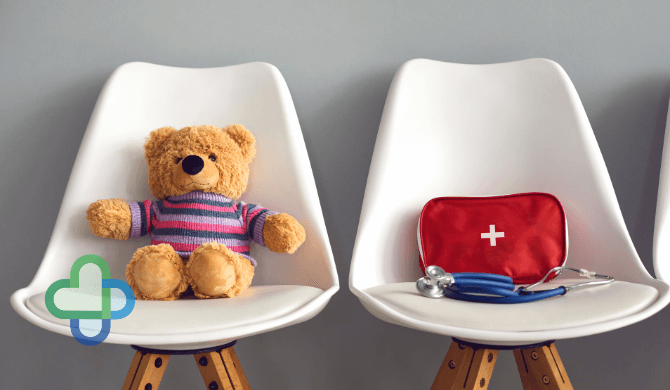A first aid box or bag should be in every family home to help when accidents happen and illnesses strike. A basic container filled with all the essential items for small emergencies could be a lifeline when you least expect it. Here’s what to keep in yours to take care of the whole family in the case of cuts, grazes, burns and minor illnesses.
At home
Having a larger kit in your kitchen or bathroom is a good base for all your first aid medical supplies to have to hand when you need them.
Items we suggest are,
- Cleansing wipes – Having cleansing wipes to hand is one of the quickest and easiest ways to clean cuts and grazes. Always use a fresh wipe and clean from the middle outwards.
- Sticky plasters- a box of plasters in different shapes and sizes can be the most useful bit of equipment to cover all kinds of minor cuts, grazes and blisters. You can even get plasters with patterns or popular characters on to help cheer up your little one after a fall or accident.
- Saline pods – these pods are full of a sterile solution and useful for cleaning wounds / as an eye wash.
- Bandages – bandages are useful for securing larger dressings over cuts and can also support a sprained ankle or joint. To secure you might also want to stock some adhesive tape.
- Gauze dressings – Sometimes you need something a bit bigger than a plaster. A gauze dressing can be held in place with the tape and/or bandages above. Or Adhesive wound dressings are a quick and easy alternative.
- Scissors and Tweezers – Scissors are handy to have to cut plasters and dressings or even your little one’s clothes should you need to. Tweezers are also great should you encounter a splinter. However, if your child is restless, the splinter is particularly stubborn or you simply don’t have tweezers to hand, a great hack is using a medicine syringe to remove a splinter or even thorn from your child’s skin using the gentle suction it provides.
- Ice packs – Ice packs are fantastic for reducing bumps and swelling. A bag of frozen veg from the freezer will work should you not have one to hand, but make sure you wrap it in something like a clean towel to prevent any cold burns caused by direct skin contact.
- Pain relief – Make sure you’re always stocked up on your choice of pain or fever relief medicine for your baby or toddler as well as syringes or spoons to administer the medicines.
- Thermometer – To establish if your child has a temperature, a thermometer is usually our first port of call. A digital ear thermometer, also known as a tympanic thermometer is the most accurate way to determine if your child has a fever. Forehead thermometers can be sensitive to changes in room temperature and strip type thermometers can only measure skin temperature, so for an accurate reading, an ear thermometer is recommended. If you have inherited an old family glass thermometer it’s important to throw these out as they have been surpassed by far safer and more accurate options.
- Antihistamine cream – For stings bites and nettle rashes an antihistamine cream will help comfort the skin and ease itching. Should your child have any allergies including grass, pollen and pets it’s also a good idea to carry antihistamine medicine. Depending on your child’s age you will need to speak to your GP first as over-the-counter antihistamine medicines can only be supplied to over 2s unless on prescription.
- Calamine lotion – Another skin soothing must is calamine lotion, ideal for treating sunburn or a chickenpox outbreak.
- Burn Gel – Burns and scalds are generally treated in the same way. Your skin has 3 layers: the epidermis (outer later), the dermis and subcutaneous fat. A superficial epidermal burn or superficial dermal burn may be treated using a burns gel as long as the skin is not broken. Depending on the extent of a burn a cooling cream or gel may be used to provide some pain relief at the site. Severe burns with broken skin, pale, darkened, painful or puss must be attended to in the hospital.
- First aid manual – When your child has an accident or gets sick it’s easy to go into panic mode and forget the basics. A simple first-aid guide will help trigger your memory and give you the basic procedures you need. Alternatively, you can download a free app from St. John’s ambulance to your phone to have all the information to hand on the go. You can download the App here.
On the go
Often when leaving the house with the family it already feels like you’re taking half of it with you! So what first aid items should you consider keeping in your bag or glove compartment?
- Sticky plasters and dressings – A small box of sticky hypoallergenic plasters like those mentioned above for cuts and grazes. If you feel like you want to take something bigger, self-adhesive wound dressings are the best as you won’t need tape and bandages to secure them.
- Antiseptic wipes – A travel pack of antiseptic wipes will save space and do the trick should you need to clean a wound.
- Instant ice packs – single-use instant ice packs like ‘koolpack ’are fantastic for on-the-go and can remain cold for up to 40 minutes at room temperature once broken. Ideal for soothing bumps and bruises.
- Travel-sized scissors and tweezers – As discussed above these have many handy uses but a tiny travel-sized version is great for saving space.
- Medicines and creams – Always pack your go-to pain and fever medicine along with an antihistamine cream.
- Burn Gel – as above
- First aid guide or app – A pocket-sized guide to paediatric first aid and CPR could be essential when you least expect it but as mentioned above a phone app is a convenient way to have everything you need to hand when on the go.
In the car
Having some extra first aid items in your car will give you peace of mind In case of emergency or breakdown. Places like Halfords sell a first aid kit specifically for the car – a link is here or you can make one up yourself including the same items as your ‘on the go’ first aid kit and adding the following:
- Gloves – Sterile Gloves would be useful especially when you are applying bandages or dressings.
- Resuscitation shield
- Foil blankets – keeping a foil blanket in the car is an effective method of prevention against hypothermia. The use of a foil survival blanket or radiation blanket helps the body retain its own body heat by reflecting escaping heat back towards the body.
How to make a First Aid Kit
You can buy standard ready-packed first aid kits (in travel size or for the home) and then add to them or create your own from scratch. A specifically made and bought first aid kit should be green with the words ‘First Aid’ but should you be creating your own you can repurpose any container or bag. The best kinds are waterproof and easy to carry as in these situations it’s often much easier and more practical to bring the kit to your injured child than to attempt to move them.
For any further help and advice for baby and children’s medicine and treatment, we are on hand. Feel free to get in touch or visit our baby & child page for more information.


